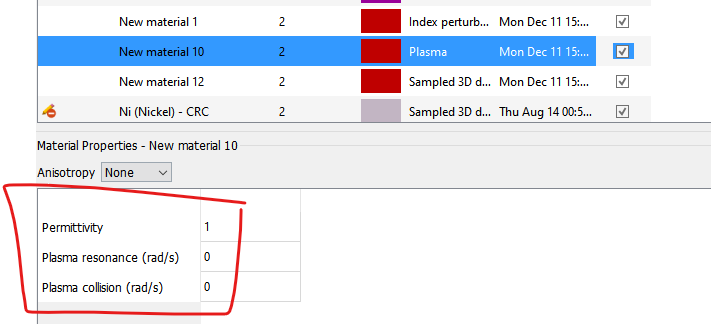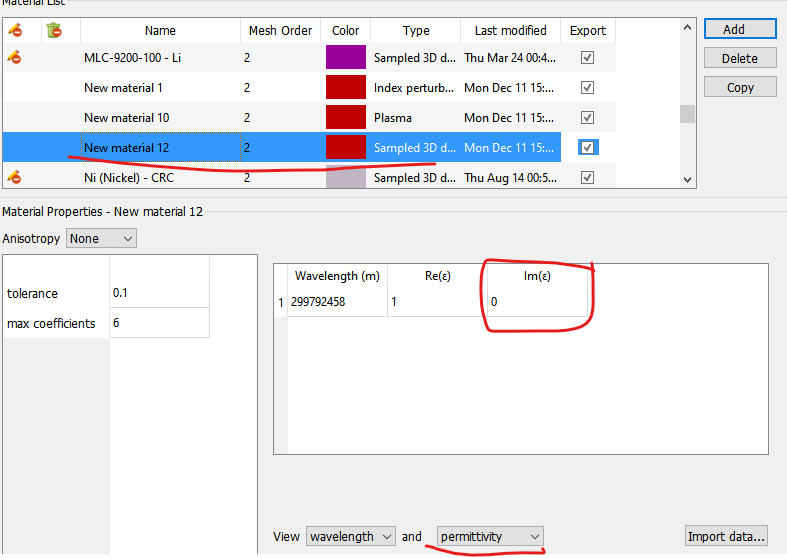-
-
December 8, 2023 at 12:03 pm
SAURAV GAUTAM
Subscriberhi
i want to create plasma drude mode with plasma and collision frequencies complex values (2.28430091876467e+15 - 4717903266445.45i, 5311954144330.36 + 1.83655713200182e+15i) but while creating matetial i can't input imaginary part as input is only real number.
Please suggest how to input complex value or shall i remove the imaginary part?
thanks
-
December 11, 2023 at 2:37 pm
Dimitris Polyzos
Ansys EmployeeHello,
It seems that there is not an option to input the imaginary part for the collision and plasma frequencies in the plasma material. However, I would suggest to add the real parts and use the plasma material model. On the other hand, you could use the real and imaginary part of permittivity/refractive index of a material (Sampled 3D). If you have the Refr indices of your material you could make a comparison between these two input materials and check if this is aligned with the reference you use. Please check both pictures below.
Also, a useful link that explains the Drude model can be found here: https://optics.ansys.com/hc/en-us/articles/360034382494-Charge-distribution-to-change-in-refractive-index-theory.
I hope I helped. Let me know if you need firther help with your model.
Kind regards
Dimitris
-
December 12, 2023 at 4:27 pm
SAURAV GAUTAM
SubscriberHi Dimitris
Thank you for your support. I used refractive index constants and calculated resonance and collision frequencies by curve fitting using equation from . https://optics.ansys.com/hc/en-us/articles/360034394634-Standard-optical-permittivity-material-models-in-FDTD-and-MODE
i considered only real parts of frequencies, the results for reflectance and transmittance are not similar with what i got from Sampled 3D.
Thanks i will check the link
-
December 15, 2023 at 4:56 am
SAURAV GAUTAM
Subscriberhi i also noticed that the Drude equation explained in https://optics.ansys.com/hc/en-us/articles/360034382494-Charge-distribution-to-change-in-refractive-index-theory is different than https://optics.ansys.com/hc/en-us/articles/360034394634-Standard-optical-permittivity-material-models-in-FDTD-and-MODE
-
December 15, 2023 at 10:39 am
Dimitris Polyzos
Ansys EmployeeHello Saurav,
This link (Charge-distribution-to-change-in-refractive-index-theory) describes the models used to calculate perturbation in refractive index from charge density data. On the other hand, this link (Standard-optical-permittivity-material-models-in-FDTD-and-MODE) describes the mathematical models of the basic permittivity (or refractive index) to create a material and import it in the material database.
The standard plasma-drude model has no imaginary part, thus means that the material you use is lossless. It is expected to not get the same results. However, I reckon that according to the reference you use the transmission/reflection results are close to the model with the imaginary part included. Is that correct?
In the meanwhile I will check with my colleagues if there is a feature that will include the imaginary part of plasma and collision frequencies in the future.
I hope I helped.
Kind regards
Dimitris
-
- The topic ‘how to create Plasma drude model material with complex input’ is closed to new replies.



-
4067
-
1487
-
1308
-
1156
-
1021

© 2025 Copyright ANSYS, Inc. All rights reserved.









